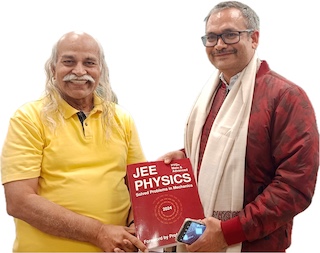Flux of Electric Field
The electric flux passing through an area $\vec{A}$ in an electric field $\vec{E}$ is given by \begin{align} \phi=\vec{E}\cdot\vec{A}. \end{align}
Problems from IIT JEE
Problem (IIT JEE 2011): Consider an electric field $\vec{E}=E_{0}\,\hat\imath$, where $E_0$ is a constant. The flux through the shaded region (as shown in figure) due to this field is,
- $2E_{0}a^2$
- $\sqrt{2}E_{0}a^2$
- $E_{0}a^2$
- $\frac{E_{0}a^2}{2}$
Solution: The flux through area vector $\vec{S}$ due to an electric field $\vec{E}$ is, \begin{align} \phi &=\oint\vec{E}\cdot\mathrm{d}\vec{S} \\ &=\vec{E}\cdot\oint\mathrm{d}\vec{S} \\ &=\vec{E}\cdot\vec{S}. \quad \text{(since $\vec{E}$ is constant.)} \end{align} The area vector of shaded region is cross product of vectors representing two sides i.e., \begin{align} \vec{S} & =(a\,\hat\jmath)\times(a\,\hat\imath+a\hat{k}) \\ &=a^2\,(\hat\imath-\hat{k}). \end{align} Use above equations to get, \begin{align} \phi &=(E_0\,\hat\imath)\cdot a^2\,(\hat\imath-\hat{k}) \\ &=E_0 a^2.\nonumber \end{align}
Exercise
An uncharged spherical conductor of radius $R$ is placed in a non-uniform electric field (see figure). The electric flux through the sphere is (i) less than zero (ii) zero or (iii) greater than zero?
